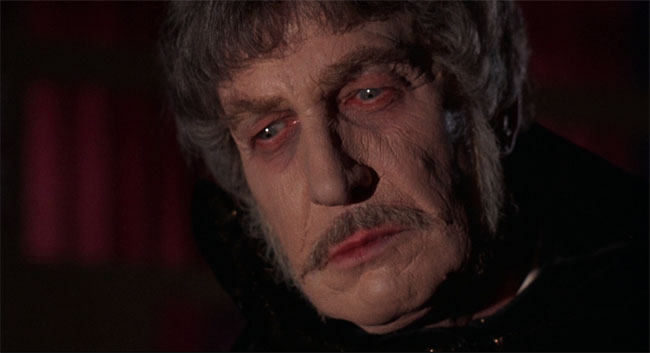
American International Pictures
When I was a kid horror movies, Godzilla and all things science fiction were what made my world go ’round. It was all my friends and I talked about. We scoured the TV Guide when it came out every week, hoping there was something good coming up on the Saturday midnight movie. War Of The Gargantuas? The Creature From The Black Lagoon? Destroy All Monsters? Good times.
Of my wish list films, one I never got the chance to see was The Abominable Dr. Phibes starring one of my favorite actors, Vincent Price. When I first heard about the film I remember looking up “abominable” as I didn’t know its meaning. It had something to do with unpleasantness I knew (Hello! The Abominable Snowman of Rudolph The Red-Nosed Reindeer!) but when I saw it defined with words such as “detestable,” “loathsome” and “hateful” well … that made seeing the film that much more important. Definitions like those only serve to pique a kid’s curiosity, you know.
But it wasn’t until years later, sometime during my high school years, that I finally got to see The Abominable Dr. Phibes.
Fast forward a generation: I decided to take it in once more (only my second time seeing it) and I’m happy to report all the kitschy, campy, horrible fates realized by Dr. Phibes and aimed at his unwitting victims were just as vivid and over-the-top as when I first saw the film. Time was kind to them, they didn’t get old in the least.
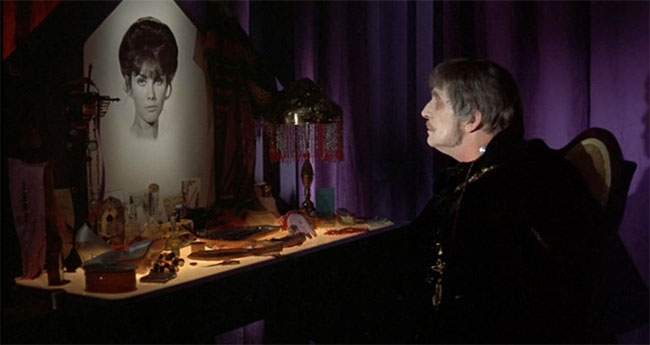
American International Pictures
If you’re not familiar with the story, Anton Phibes (Price), an authority in the fields of theology and music, was thought killed in a horrible car accident in 1921, this coming shortly after the death of his wife, Victoria, from a supposed botched operation.
But Phibes didn’t die. Scarred, disfigured and unable to speak, the doctor uses his knowledge of acoustics to speak once more through electronics. His ghastly features, on the other hand, aren’t so easily remedied. Too gruesome to look at, he hides his horrible looks behind self-made prosthetics and a wig. Years later, Phibes reappears bent on exacting revenge against the medical staff (led by Joseph Cotten’s Dr. Vesalius) he blames for his beloved’s death.
The methods of death Phibes employs are all part of the campy, grisly fun of The Abominable Dr. Phibes, as are some of the bumbling efforts of Scotland Yard’s Inspector Trout (Peter Jeffrey), who has deduced it’s Phibes behind the murders. The creative doctor bases each act of butchery on the plagues brought on Egypt by God as detailed in The Old Testament (and sometimes very loosely). In order of appearance the plagues are: boils, bats, frogs, blood, hail, rats, beasts, locusts, death of the the first born and darkness. (There was no scourge of bats or rats in The Old Testament but, respectively, the original plagues of lice or gnats and flies were used as inspirations for those items.)
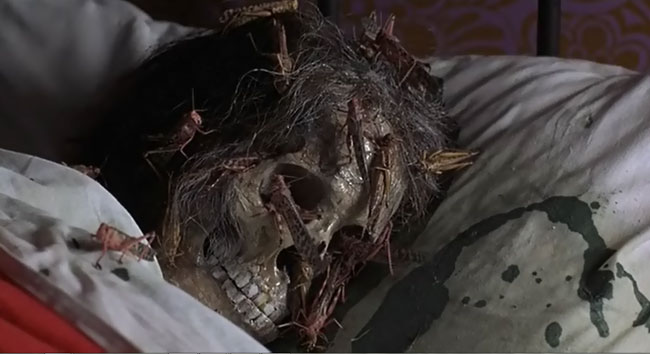
American International Pictures
It’s the plagues of frogs, beasts and locusts that are the most gruesome in the story. In order, two doctors and a nurse are subject to these particular horrors: One doctor has his head crushed by a frog headdress while attending a costume party and the other has his torso run through by the spire of a brass unicorn. (Ouch!) But it’s the nurse who is the unfortunate recipient of the most hideous of the curses; Phibes concocts a soupy substance made from Brussels sprouts to lure locusts to the sleeping nurse and she’s eaten alive by the voracious insects. *shudder*
Phibes reserves the penultimate plague realization — death of the first born — for the doctor he holds most accountable in his wife’s death: Dr. Vesalius, the head doctor who oversaw her fateful operation. It’s Vesalius’ son who is the subject of Phibes’ eerie final crime. With the boy strapped to a table, Vesalius must extract a key surgically implanted by Phibes near the boy’s heart. By removing the key in a 6 minute window stipulated by Phibes, Vesalius will use it to stop an acid rain from killing the boy … if he can.
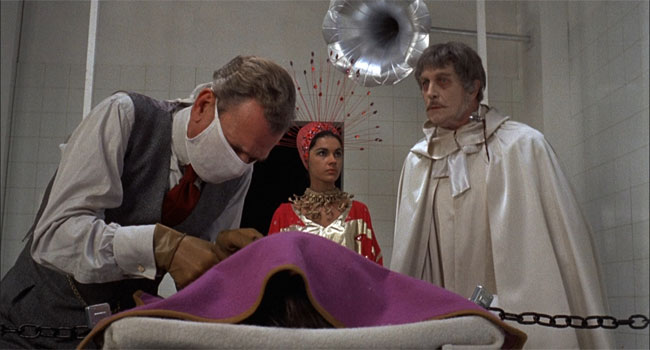
American International Pictures
Does Vesalius perform the operation with room to spare? Or is Phibes triumphant in this final devious plan? Is Phibes finally apprehended by Inspector Trout? Or does he escape with all those murders beneath his belt?
The main players in the film — Price, Jeffrey and Cotten — all perform wonderfully. Price is especially fine with turns both menacing and campy in equal measure. Jeffrey is a treat as the sometimes bumbling, sometimes dead to rights detective doing his best to get a step ahead of Phibes and his dastardly doings. There are lots of fun surprises in the film, an uncredited “performance” (such that it is) by fashion model Caroline Munroe (The Spy Who Loved Me, The Golden Voyage Of Sinbad) and Phibes’ funky automaton band (“Dr. Phibes Clockwork Wizards” who often accompany him as he plays organ) among them.
Speaking of Phibes’ organ playing, the real turkey of the film is the organ music. Talk about camp. For someone who was renown for his musical abilities, Phibes sure doesn’t show off any classical (or even adept) chops.
Lastly: Does Phibes meet his end at the film’s conclusion?
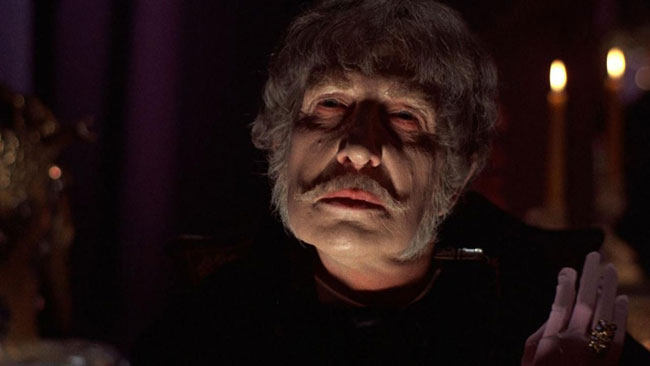
American International Pictures
**SPOILER** NO! He does not! He comes back to murder once more in the sequel …
Dr. Phibes Rises Again … !!!
(Check back later as I will be talking about Phibes’ further adventures soon …)
